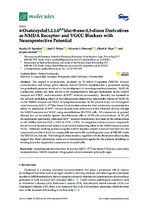| dc.contributor.author | Egunlusi, Ayodeji O | |
| dc.contributor.author | Omoruyi, Sylvester I | |
| dc.contributor.author | Malan, Sarel F | |
| dc.date.accessioned | 2020-12-01T13:21:13Z | |
| dc.date.available | 2020-12-01T13:21:13Z | |
| dc.date.issued | 2020 | |
| dc.identifier.citation | Egunlusi. A.O. et al. (2020). 4-Oxatricyclo[5.2.1.02,6]dec-8-ene-3,5-dione derivatives as NMDA receptor- and VGCC blockers with neuroprotective potential. Molecule, 25(19),4552 | en_US |
| dc.identifier.issn | 14203049 | |
| dc.identifier.uri | 10.3390/molecules25194552 | |
| dc.identifier.uri | http://hdl.handle.net/10566/5474 | |
| dc.description.abstract | The impact of excitotoxicity mediated by N-methyl-D-aspartate (NMDA) receptor
overactivation and voltage gated calcium channel (VGCC) depolarization is prominent among
the postulated processes involved in the development of neurodegenerative disorders. NGP1-01,
a polycyclic amine, has been shown to be neuroprotective through modulation of the NMDA
receptor and VGCC, and attenuation of MPP+-induced neurotoxicity. Recently, we reported on
the calcium modulating effects of tricycloundecene derivatives, structurally similar to NGP1-01,
on the NMDA receptor and VGCC of synaptoneurosomes. In the present study, we investigated
novel 4-oxatricyclo[5.2.1.02,6]dec-8-ene-3,5-dione derivatives for their cytotoxicity, neuroprotective
effects via attenuation of MPP+-induced neurotoxicity and calcium influx inhibition abilities through
the NMDA receptor and VGCC using neuroblastoma SH-SY5Y cells. All compounds, in general,
showed low or no toxicity against neuroblastoma cells at 10–50 µM concentrations. At 10 µM,
all compounds significantly attenuated MPP+-induced neurotoxicity as evident by the enhancement
in cell viability between 23.05 ± 3.45% to 53.56 ± 9.29%. In comparison to known active compounds,
the derivatives demonstrated mono or dual calcium modulating effect on the NMDA receptor and/or
VGCC. Molecular docking studies using the NMDA receptor protein structure indicated that the
compounds are able to bind in a comparable manner to the crystallographic pose of MK-801 inside
the NMDA ion channel. The biological characteristics, together with results from in silico studies,
suggest that these compounds could act as neuroprotective agents for the purpose of halting or
slowing down the degenerative processes in neuronal cells. | en_US |
| dc.language.iso | en | en_US |
| dc.publisher | MDPI | en_US |
| dc.subject | Neurodegenerative disorders | en_US |
| dc.subject | NMDA receptor | en_US |
| dc.subject | Voltage gated calcium channels | en_US |
| dc.subject | Polycyclic cages | en_US |
| dc.title | 4-Oxatricyclo[5.2.1.02,6]dec-8-ene-3,5-dione derivatives as NMDA receptor- and VGCC blockers with neuroprotective potential | en_US |
| dc.type | Article | en_US |

